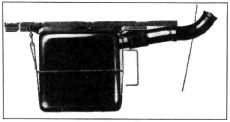1942 - 1947 CHEVROLET SHOP MANUAL
Section 8 - Fuel Tank & Exhaust System
|
|
|||
|
8-2 |
|||
|
|
|||
|
tirely. To provide this clearance,
when such an adjustment becomes
necessary, loosen the hose clamps connecting the filler neck to the
tank proper, and pull the
filler neck out through the grommet the required
distance.
1/2-TON TRUCK (Except Cab
Type)
The fuel
tank of the 1/2-ton panel and chassis type truck is located on the right side of
the chassis, just inside the
frame side rail and between the
second and third cross members. A strong mounting of two straps supports it
underneath the floor, the front strap being attached to the steel
floor at the front of the body and
the rear one to a flanged
channel which is used to reinforce the floor boards at this point, at the same
time making possible a durable support for the rear
strap.
The steel
floor at the front strap has a large stiffening rib stamped crosswise in it,
thus providing a support
for the front of the tank similar to the cross brace at the rear. Metal-to-metal
contact is prevented by anti-squeak material. The tank is also set far enough from the side rail to
prevent any rubbing. A covered
opening is provided in the floor for access to the tank gauge
unit.
This tank
is of heavy, leak-proof construction and has a capacity of sixteen gallons. It
consists of two similar pans,
welded together and reinforced with stiffening ribs around the
sides. The filler neck extends
through the body panel and is designed to permit rapid filling of the
tank. A special vent tube
extends the entire length of the filler neck into the top of the tank. A
large baffle near the neck prevents surging. This fuel tank and
its mounting is shown in Fig.
2. |
to the
frame side rail by two brackets and two straps. The brackets are bolted to the frame
side rail and the straps,
which go around the tank, are in turn fastened to the
brackets.
The tank
construction is also similar to the 1/2-ton truck except for the increased capacity
of 18 gallons.
ALL
1/2, 3/4 AND 1-1/2-TON CAB TYPE TRUCKS
An eighteen-gallon fuel tank is
used on all cab trucks and the
1-1/2-ton single unit body trucks. The tank is mounted directly on top of the
frame under the driver's seat.
A riser formed across the top
half of one end of the tank prevents air from being trapped by fuel entering the tank from
the filler neck.
On all cab
type trucks the filler neck emerges from the end of the riser while on the
1-1/2-ton single unit body
trucks, the filler neck projects from the side of the riser. In both cases,
the filler neck extends
outside the body. Where it goes through the body panel, a moulded
rubber grommet seals the
clearance hole and prevents spilled gasoline from entering the cab or
body.
With the
filler neck attached to the riser, which is the highest point of the fuel tank, rapid
filling of the fuel tank is possible without the possibility of fuel being blown out again by trapped
air.
The same
ventilated type filler cap as used on the passenger cars is used on all
trucks.
GASOLINE TANK CAPACITIES |
||
|
Passenger Cars and Sedan
Delivery 16 Gallons
54-Ton Truck (Except Cab Types) .
. 16 Gallons 54-Ton Cab Type Trucks,
All 3/4
and l-1/2-Ton Trucks............ 18 Gallons |
|||
 |
|||
|
EXHAUST SYSTEM PASSENGER
CARS
The muffler, shown in Fig. 3, is a
five-tube, reverse flow assembly
for silencing plus a tuned resonance chamber. The assembly is oval in
shape, |
|||
|
|
|||
|
Fig. 2- 1/2-Ton Track Fuel Tank (Except Cab
Type} |
 |
||
|
ALL 3/4-TON
TRUCKS
(EXCEPT CAB TYPE)
The
18-gallon fuel tank used on the 3/4-ton truck is located in the same relative position to
the frame as on the 1/2
truck. The mounting is similar to the 1/2-ton truck except that
instead of being attached to
the load platform the tank is anchored |
|||
|
Fig. 3—Passenger Car Muffler |
|||
|
|
|||